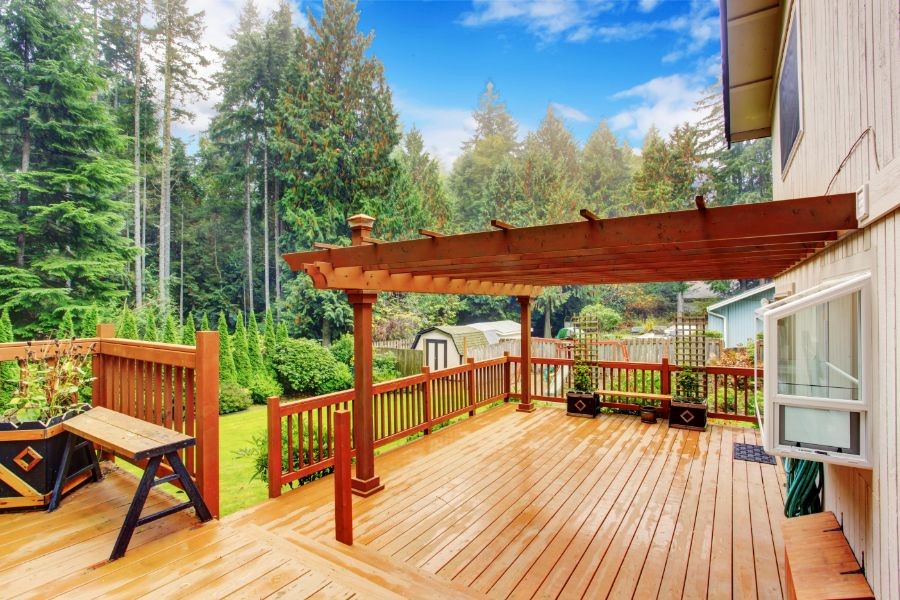Weatherproofing Your Deck: From Materials to Maintenance

Decks expand living space outdoors, but the elements can deteriorate these exposed structures over time. Effective weatherproofing is crucial when it comes to protecting your investment and preventing safety issues such as loose boards or railings.
Planning and Design Strategies
Weatherproofing considerations start during the planning and design phase before construction even begins. Optimal overhang sizing of 2-3 feet helps protect the deck boards and structure from excessive water exposure. Proper site grading directs rain runoff away from the deck perimeter. On sloped hillside sites, incorporate terracing or subtle retaining walls to reduce erosion and moisture buildup under the deck.
Incorporate wide stairs with multiple stringers and support posts for strength. Open-sided stairs allow ventilation and drainage. Plan the overall deck layout to minimize seams between boards and complicated joints. This provides fewer entry points for water infiltration. Use 6×6 beams for heavyweight structural support against forces. Design the decking spacing, pattern and gaps to allow drainage between boards. An open lattice substructure or clear polycarbonate decking combats pooling.
Material Selection for Weather Resistance
The right building materials make all the difference for deck weathering ability. Naturally decay-resistant woods like cedar, redwood or cypress have built-in durability, or pressure-treated pine is an economical option resistant to rot and insect damage. Tropical hardwoods like Ipe, cumaru, and massaranduba have extremely high oil content to repel water. Choose defect-free, kiln-dried lumber for maximum stability. Durable composite decking lasts for decades but expands and contracts significantly with temperature changes.
The experts over at SPAX recommend the use of corrosion-resistant joist hangers, railing anchors, nails and decking screws rated for exterior use. Look for G185 hot-dipped galvanized or stainless steel hardware. Pre-drilling very dense exotic hardwoods prevents cracking and screw head mushrooming. For stairs, metal stringers and cable railings far outlast wood counterparts when exposed to the elements.
Construction Techniques Extend Deck Life
Proper construction and integration with the home are also paramount for weatherproofing. Attach the ledger board securely to the band board with lags and joist hangers. Use an adhesive flashing membrane between the ledger and house to prevent moisture entry and rot. Install footings for corner posts below the frost line for stability. Keep joist and fastener spacing tight for a solid deck frame less prone to wobbling and squeaking over time when exposed to rain and moisture.
Maintain a 1/8-1/4” gap between deck boards to allow drainage and expansion with changes in humidity and temperature. Use hidden fastener systems for a smooth surface and water resistance. Pre-drill decking screws, especially for dense exotic woods, to prevent cracking and wood fiber tears which admit moisture.
Maintenance for Weather Protection
Regular maintenance preserves your deck investment against sun, rain, and other elemental damage. Inspect at least yearly – a quick catch saves more extensive repairs later. Tighten any loose railing connections, anchors, or hardware. Clean out clogged gaps between boards allowing drainage. Refasten popped nails or eroded decking screws. Lightly sand any splinters and reapply protective penetrating finish.
Clean any weathered surfaces thoroughly with a pressure washer so as to remove mold, mildew, grime, and prep for refinishing. Spot-treat any fungus or mildew right away to prevent spreading. Reseal stripped areas and consider full refinishing every 2-3 years. Repair cracked boards, damaged post bases and deteriorated stairs early on before major problems arise. A well-weatherproofed deck starts with smart materials and design, proper construction, and diligent maintenance.
Conclusion
Your deck represents a significant investment that proactive weatherproofing practices can protect. Take steps now to fully weatherproof your deck against the elements for many enjoyable seasons to come.
| Покердом мфц-сакмара.рф |